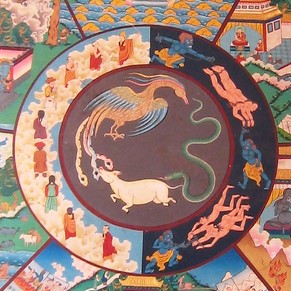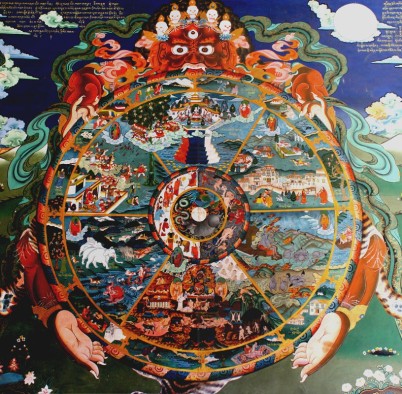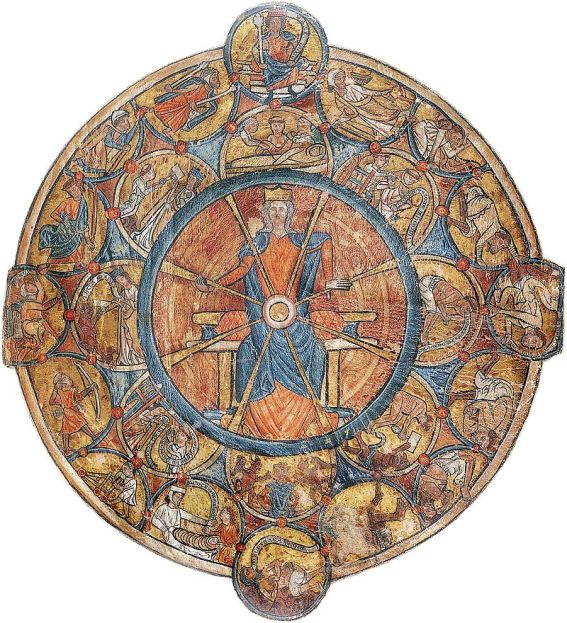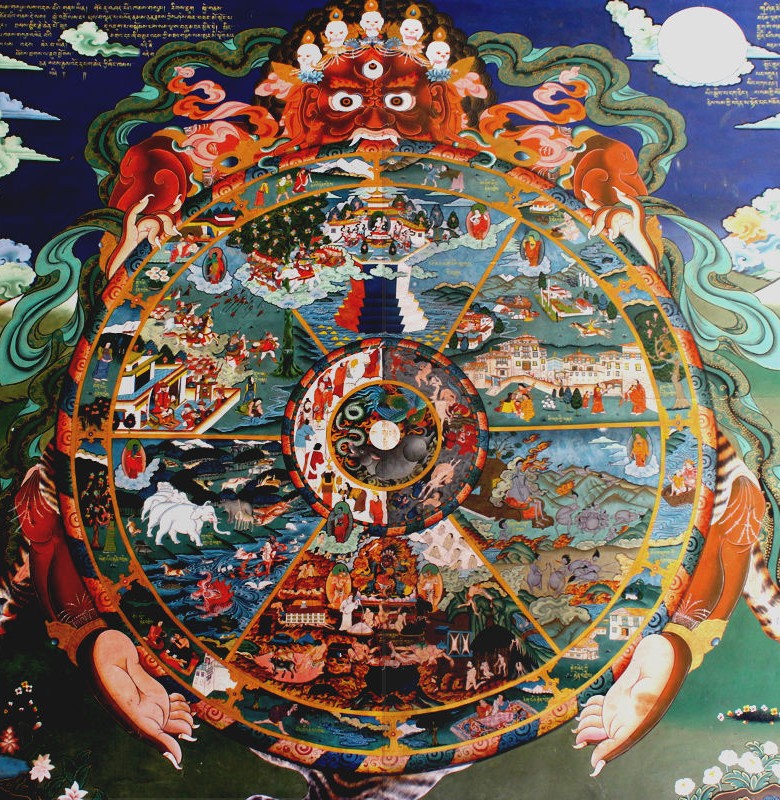The Buddhist Bhavachakra is a form of mandala – any diagrammatic representation of the universe/worldview in Asian religious art used for sacred rites and meditation – largely found in Mahayana Buddhist monasteries in the Indo-Tibetan region, either painted directly on the walls or on wall hangings (thangka). Known as the “wheel of life” or the “wheel of becoming” or the “wheel of cyclic existence”, the Bhavachakra is a symbol of samsara (literally “continuous movement” in Sanskrit) – the repetitive cycle of birth, death and rebirth that arises out of ignorance and is characterised by suffering (dukkha). It is believed that the Buddha himself developed the concept of the artwork to communicate Buddhist philosophy to a general audience.
(1) THE THREE POISONS, (2) KARMA

Complex and multi-layered, the Bhavachakra, at its very centre contains the Three Poisons (kleshas) of Ignorance (a pig), Aversion (a snake) and Attachment (a bird). It is these three that set the whole wheel in motion and lead to both negative and positive human action. The hellish and heavenly destinies are indicated by the semi-circles of black and white immediately surrounding the three animals. The full circle represents Karma, the universal law of cause and effect. People on the dark path, through much disturbance, move down realms of existence while those on the bright path peacefully and smoothly keep moving up.
(3) THE SIX REALMS OF SAMSARA
The third layer consists of six wedge-shaped sections, which are the realms of samsara (three higher and three lower). The upper half contains the three higher realms – Deva realm (god realm), Asura realm (demi-god realm) and Manuṣya (human realm). The second half contains the three lower realms – Tiryagyoni realm (animal realm), Preta realm (hungry ghost realm) and Naraka realm (hell realm). The first three are more pleasant but all six ultimately remain domains of suffering.
The gods, who in Buddhism are entities more powerful than human beings but undeserving of worship, are inclined to lives of pleasure and abundance. Vain, easily distracted and complacent, they are not committed to the pursuit of dharma (moral duty). As a result, they end up being re-born in the lower realms. The demi-gods, lower gods, are also situated in a luxurious surrounding but are too disposed to envy to be content and comfortable. They spend most of their time fighting among each other and also with the gods above. The humans suffer from sickness and death and do not easily get their wishes fulfilled. Yet their realm is most conducive to the practice of dharma as they are neither in extreme pleasure (like the gods and the demi-gods) nor in extreme pain (like the figures of the three lower realms).

Below, the animals, sentient beings that are less intellectually advanced than humans, live in the fear of being attacked and with the aggression of attacking others. Although, they are driven by instincts and have little freedom of rational decision-making, they are subject to the rules of karma. Hungry ghosts with thin necks, huge bellies and insatiable appetites. Constantly in such of food and drink, they move about in agony. Rarely do they find stuff that can satisfy their hunger and thirst. Finally, the beings of hell endure unimaginable torments for unthinkable periods of time. One’s stay in hell needn’t be eternal, though. It can be escaped through right conduct.

The six realms of samsara are results of six specific negative emotions: pride (god-realm), jealousy (demi-god realm), desire (human realm), ignorance (animal realm), greed (hungry ghost realm), and anger (hell realm).
(4) THE TWELVE LINKS
The fourth layer of the Bhavachakra contains the Twelve Nidānas (or “twelve links” or “twelve-fold chain”) that demonstrates just how the three poisons, through karma, result in the six realms of samsara. Here the conditionality and causality of cyclical existence are shown in detail. These interdependent phenomena shed light on karma.
- Avidyā lack of knowledge – a blind person, often walking, or a person peering out
- Saṃskāra constructive volitional activity – a potter shaping a vessel or vessels
- Vijñāna consciousness – a man or a monkey grasping a fruit
- Nāmarūpa name and form (constituent elements of mental and physical existence) – two men afloat in a boat
- Ṣaḍāyatana six senses (eye, ear, nose, tongue, body, and mind) – a dwelling with six windows
- Sparśa contact – lovers consorting, kissing, or entwined
- Vedanā pain – an arrow to the eye
- Tṛṣṇa thirst – a drinker receiving drink
- Upādāna grasping – a man or a monkey picking fruit
- Bhava coming to be – a couple engaged in intercourse, a standing, leaping, or reflective person
- Jāti being born – woman giving birth
- Jarāmaraṇa old age and death – corpse being carried
(5) YAMA, (6) THE BUDDHA AND THE MOON

The four layers of the wheel are held by a huge, menacing figure. He is Yama (deity found in many Asian religions) – the lord of death, king of hell, god of the underworld, who symbolises impermanence.
His four limbs are the four sufferings of birth, sickness, old-age and death. His third eye means an understanding of impermanence. His third eye His crown of five skulls refer to the five aggregates (skandhas), the functions or aspects of sentient beings: material form, feelings, perception, volition (or mental formations) and sensory consciousness.
Beyond the wheel, the Buddha stands pointing to the moon (the path of liberation). This can be called nirvana – the cessation of all unpleasant aches and pains.

—-
There are several interpretations of the Bhavachakra. Of later, Mark Epstein, the American psychotherapist has remarked:
The core question of Buddhist practice, after all, is the psychological one of “Who am I?” Investigating this question requires exploration of the entire wheel. Each realm becomes not so much a specific place but rather a metaphor for a different psychological state, with the entire wheel becoming a representation of neurotic suffering…The entire Wheel of Life is but a representation of the possibility of transforming suffering by changing the way we relate to it. As the Buddha taught in his final exhortation to his faithful attendant Ananda, it is only through becoming a “lamp unto yourself” that enlightenment can be won. Liberation from the Wheel of Life does not mean escape, the Buddha implied. It means clear perception of oneself, of the entire range of the human experience…
~ Thoughts Without a Thinker: Psychotherapy from a Buddhist Perspective (2004)

—-
In Western art, works similar to the Bhavachakra in content and style would be The Wheel of Fortune by the English manuscript illustrator Willliam de Brailes (active c. 1230 – c. 1260) and The Seven Deadly Things and the Four Last Things (c. 1500) by the Early Netherlandish painter Hieronymus Bosch (c. 1450 – 1516). More on them some other day!


Further Reading:
The Princeton Dictionary of Buddhism (2013) by Robert E. Buswell and Donald S. Lopez
Encyclopedia of Buddhism (2004) by Damien Keown and Charles S. Prebish (eds.)
The Art of Buddhism: An Introduction to its History and Meaning (2009) by Denise Party Leidy
Buddhist Art and Architecture (1993) by Robert E. Fisher
—-
Image Credits:
Featured: Bhutanese Buddhist Bhavachakra (slightly enhanced and cropped) by User “Nagarjun Kandukuru”, CC BY 2.0, Flickr
Other (1): Wheel of Life at Kopan Monastery, Kathmandu, Nepal (cropped) by User “Zionorbi”, CC By 2.0, Wikimedia Commons
Other (2): Bhavachakra (cropped) by User “Mistvan”, GFDL, Wikimedia Commons
Other (3): Bhavachakra (cropped) by User “Mistvan”, GFDL, Wikimedia Commons
Other (4): Same as featured
Other (5): Same as featured
Other (6): Bhavachakra by “wellcomeimages.org”, CC BY 4.0, Wikimedia Commons
—-
![]()

An excellent and thorough post.
LikeLiked by 2 people
Thanks a lot! I found the outer rim pretty complicated.
LikeLiked by 2 people
Only the outer rim? You’re doing well! Looking at the mandala I am struck by the cultural and historical wealth that it embodies. A week ago a British academic was interviewed on ABC radio about his new book in which he argues for the historical significance of Middle Eastern and Asian cultures – that before the centres of learning were in Paris and Oxford they were in the Middle East and Asia, that people in the West know so much about artists and religions in the West but so little about those beyond it. On that basis alone, congratulations on your post. Phil
LikeLiked by 2 people
I’m glad I’ve had a chance to engage with both the East and the West. Intellectual wealth is all over the place. For that reason, I try to be as global as possible on my blog. Tomorrow I hope to post on a wonderful Iranian-Iraqi film.
ABC Radio…where in Australia do you live?
LikeLiked by 2 people
I’m in Sydney and very much want to move to Asia. Where do you live? The link for the interview I referred to is http://www.abc.net.au/radionational/programs/latenightlive/a-new-history-of-the-world/7282586. I look forward to your post on that film.
LikeLiked by 2 people
I’m currently in my hometown in central India. A place called Jabalpur. I’ve studied in Bangkok and London and also spent some time in Toronto. I hope to move to Australia for a year…then let’s see where.
Thanks for the link!
LikeLiked by 2 people
I thought you were in the US. Cheers to an international scholar!
LikeLiked by 2 people
I do have family there (California). Will certainly visit in future!
LikeLiked by 2 people
What a beautiful blog, thank you for sharing it with us 🙂
LikeLiked by 2 people
Thanks for appreciating it! I hope I am able to maintain (and improve) it. 🙂
LikeLiked by 1 person
You writing is really informative.:).Could you please tell me the importance of big roller drum engraved with writings found inside the buddhist monastry at Dharmshala , Himachal Pradesh?
LikeLiked by 2 people
Thank you for the compliment. “Big roller drum” — do you mean “prayer wheel”… here are two good pieces of text explaining their significance:
http://www.garudashop.com/Prayer_Wheels_s/45.htm
http://www.nyingma.org/PrayerWheels/index.html
LikeLiked by 2 people
I sincerly apologize for the usage of my word.I visited Dharmashala seven years ago and the monastery was most peaceful and beautiful place i had ever visited.I also saw the prayer function by monks. And the article was really helpful.Thank You.
LikeLike
I didn’t know what it was called myself 🙂 I lived in Thailand for 4 years…so I am more familiar with Theraveda Buddhism…that culture is quite different from the Mahayana tradition of the Indo-Tibetan region.
LikeLike
Beautiful blog and informative post..thanks for peeping in..
LikeLiked by 1 person
Thanks a lot 🙂 and you’re welcome.
LikeLiked by 1 person
Very interesting. In recent months I watch the lectures by Robert Thurman on YouTube. Buddhism for me is realism without cynicism.
LikeLiked by 1 person
Thank you. Robert Thurman must be Uma Thurman’s father?
At first, Buddhism did look somewhat pessimistic to me. I started appreciating it when I began taking it on its own terms, without the lens of Judeo-Christian thought. It could indeed be very life-enhancing.
LikeLike
Seriously impressive and thorough research! Thank you.
Have you seen the film Samsara? Some really gorgeous footage of mandala paintings in that, you might enjoy.
Oh, and beautiful blog by the way.
Emily x
LikeLiked by 1 person
Thanks a lot 🙂 I’ve not watched the movie but heard about it.
LikeLike